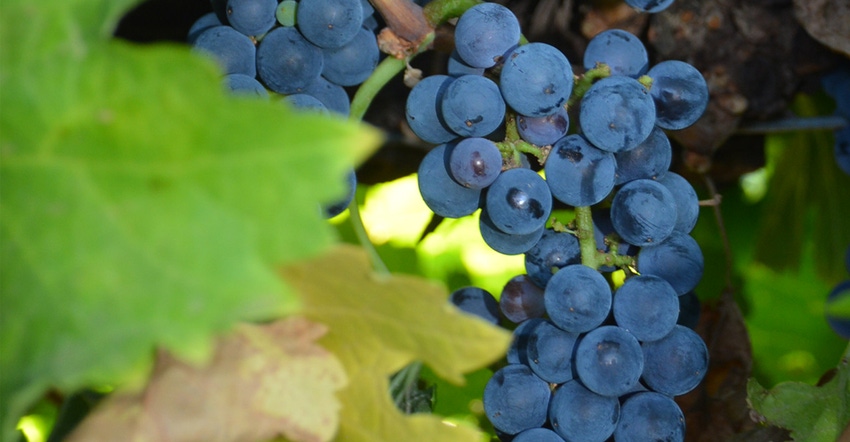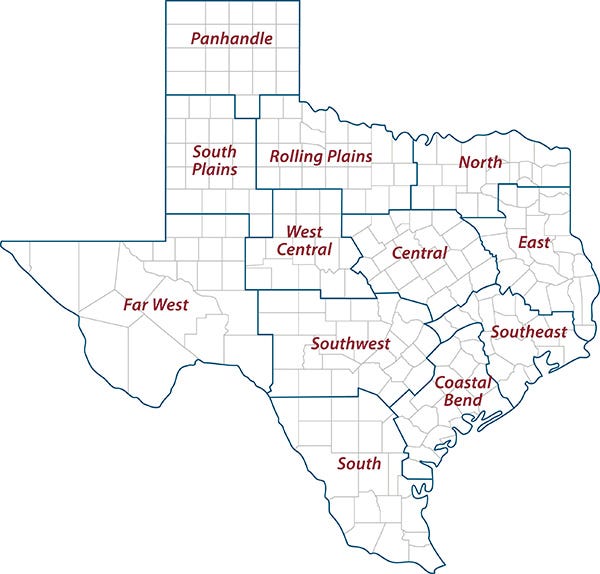
A challenging year for vineyards could culminate with exceptional 2019 wines from Texas wine grapes, according to Texas A&M AgriLife Extension Service experts.
Michael Cook, AgriLife Extension viticulture program specialist, Denton, said the 2019 wine grape season was challenging for producers, and vines were showing lower yields but very good quality fruit for winemaking.
“This season has been the tale of two extremes for most producers,” he said. “We had an exceptionally wet spring from the Gulf Coast to Hill Country and High Plains over to North Texas. Ample rains started in the fall and didn’t stop. All that rain was a blessing and a curse.”
Cook said vines emerged uniformly at bud break due to consistent rains, but strong, steady growth required more canopy management. Moisture also meant more intense disease pressure from fungal pathogens, including black rot and downy mildew.
“Downy mildew was especially pervasive this season due to the abundance of rain,” he said. “It was a major threat to producers who were not steadfast in their proactive management strategies. But I think most producers were prepared and adapted to the disease pressure.”
Brianna Hoge, AgriLife Extension viticulture specialist, Fredricksburg, said Hill Country vineyards dealt with a full array of bacterial and fungal pathogens this season as well, including sour rot, bunch rot and botrytis.
“Some producers maybe sprayed a little late, but it’s definitely been a busy season,” she said. “Disease pressure kept everyone on their toes.”
Cook said lower-than-normal yields in most vineyards were attributed to late April storms that impacted fruit set during bloom.
“The wind, rain and cloudy days slightly reduced fruit set at that critical time,” he said. “Vineyards in the High Plains are expecting higher yields because their vines were not in full bloom when those storms were occurring.”
Hoge said Hill Country grape yields were similarly low but she believes berry weights could make up for reduced fruit sets. The weather also meant vines required less thinning.
Despite slight losses, Cook said vineyards along the Gulf Coast and Northeast Texas have reported high-quality grapes from their earlier harvest varieties. Hoge said Hill Country grape quality was expected to be exceptional.
“The reduced fruit set meant vines could put more energy into each berry,” she said. “The rain and cooler temperatures also kept pH levels below 4, which is good, and brix levels – the sugar content in grapes – were good overall.”
Soil leaching from heavy rains benefitted and detracted from vine production, Cook said. Sodium leaching benefitted vines, while producers had to be more attentive to nitrogen management, as nitrogen is easily lost through the soil during intense rain events.
Hot weather coupled with late-season drought swung the weather extreme the other direction over the last several weeks. Mother Nature quickly went from deluge to drought, he said.
“Drought conditions in late season from such a wet fall and spring caught some producers off guard,” he said. “Vines were living the good life early in the season and now the ground is cracking, temperatures are searing and vines are responding to the added stress.”
Cook said Texas’ long growing season should allow producers enough time to harvest and maintain irrigation levels to help vines recover from dry conditions and store ample energy in their roots and trunks for the winter months.
“Producers should monitor irrigation closely to help vines produce carbohydrates, which will help productivity next season,” he said.
Despite challenges, both Hoge and Cook used the word “excited” when talking about the potential 2019 wines.
“We’re all excited about the quality of the fruit coming into the wineries to be crushed,” Cook said. “It was a challenging year, but it looks to be another good season for Texas vineyards.”
AgriLife Extension district reporters compiled the following summaries:

CENTRAL: High temperatures continued to dry soils. Rain was received in a few areas. All crops were OK, but they needed rain. Temperatures reached the 100-degree mark. Producers were still making hay. Producers reported stem maggot damage in Coastal Bermuda grass. Another week of dry weather with crops maturing out. Livestock were in good condition. Hot, dry weather increased irrigation efforts. The first milo cutting was underway. Corn harvest started and should ramp up next week. Pastures and rangelands were doing very well.
ROLLING PLAINS: No report.
COASTAL BEND: Some very small, spotty showers fell, but mostly hot and dry conditions prevailed. Dry conditions helped producers get into fields to harvest. Corn and grain sorghum yields were average to above average. Cotton was being harvested in the southern area, and bolls were opening in other areas. Some early rice reached maturity and was being harvested. Aphids were becoming a problem on pecans. Pastures and hay fields were declining and needed rain. Hay producers made a second hay cutting but will need moisture to make a third. Stock ponds were drying up. Livestock were in good condition.
EAST: Conditions were drying up in most of the district. Some areas received spotty showers. Hay production was in full swing. Jasper County, however, reported hay baling was delayed due to standing water in pastures. Harrison County reported hay producers needed rain for fertilizer to kick in and make another cutting possible. Pasture and rangeland conditions were fair to good. Subsoil and topsoil conditions were adequate. Local cattle markets looked good. Wild pig activity was up, causing lots of damage. Bermuda grass stem maggot infestations increased. Grasshoppers and armyworms were also reported.
SOUTH PLAINS: Topsoil and subsoil moisture levels were dropping rapidly due to high heat and wind drying out the ground. Warm temperatures provided needed heat units for cotton, which continued to progress and mature well. Producers continued to irrigate with no rain in the forecast. Pastures and rangelands were in good condition. Cattle were in good condition.
PANHANDLE: Producers irrigated heavily amid triple-digit temperatures. Corn was holding on. Cotton progressed well due to good heat units. Corn, cotton and sorghum were behind in growth. High nighttime temperatures and extreme daytime temperatures helped cotton in the northern Panhandle improve. Southeastern Panhandle rangeland was in critical condition due to lack of rain. Cattle conditions declined across the district. Adequate topsoil, and short subsoil moisture levels were recorded throughout the district.
NORTH: Conditions were hot and dry, and soil moisture was short to adequate across the district. Some counties reported a few inches of rainfall but nothing significant enough to change moisture conditions. Grasses were not as productive as they were a month ago due to high temperatures and dry conditions. Corn, soybeans and cotton were doing well. Some corn farmers reported very little pressure from insects and disease this year, and they look to start harvesting soon. Most sorghum farmers had to do some spraying to control insects. The pecan crop looked good, but many trees have experienced premature nut dropping. Livestock were in good condition. Stocker calves were mostly healthy. Hay was harvested, and some producers were advertising hay for sale.
FAR WEST: Average temperature highs were into the 100s with lows in the 60s. Trace amounts of precipitation were reported in the westernmost parts of the district. Cotton bolls were beginning to set. Pecan orchards were beginning to show their yield potential and looked good. Pastures were starting to show stress from the lack of rain, but there was still plenty of forage available. Livestock conditions remained fair to good according to the herds’ forage availability.
WEST CENTRAL: Conditions were very hot and dry across the district. Drought stress was becoming a factor for rangelands, pastures and some croplands. Cotton fields were in mostly good condition and beginning to bloom. Grain sorghum was in good condition with harvest beginning in some areas. Hayfields were in fair condition but declining due to lack of rain. Rangeland and pasture conditions were deteriorating. Some livestock producers supplemented hay to feed cattle. The cattle market opened the week steady on all classes.
SOUTHEAST: Rice was expected to be harvested on a large scale next week. The district reported several days of heavy morning rain showers. Areas that didn’t receive rain were drying out. Brazos County was experiencing high temperatures. In Grimes County, most pastures were drying out and could use rain, but some areas received small showers. A few cornfields were being harvested. Hay was still being cut. Rangeland and pasture ratings were excellent to very poor with good being most common. Soil moisture levels ranged from adequate to surplus with adequate being most common.
SOUTHWEST: Hot temperatures persisted, and rangeland and pasture conditions were declining. The district needed rain. Fire hazard risks were a concern. Good corn yields were reported in harvested fields. Livestock were in fair to good shape.
SOUTH: Northern, eastern and western parts of the district were hot and dry with short to very short soil moisture levels. Southernmost parts of the district reported hot conditions and short to adequate soil moisture. Most areas reported high temperatures beyond 100 degrees. Corn harvest and sorghum harvest started in some areas and completed in others, and yields were above average in Live Oak County. Cotton bolls were opening and some cotton was being irrigated. Cotton under irrigation made good progress. Cotton producers in Jim Wells County were actively harvesting and should progress rapidly in the coming weeks. Peanuts were setting pods and were also under irrigation. Pasture and rangeland conditions continued to decline due to lack of rainfall. McMullen County reported continued high temperatures coupled with winds further deteriorated soil moisture and rangeland conditions. Pasture and rangeland conditions were declining rapidly in the high temperatures. Rangeland and pasture conditions were poor in Zapata County, and producers needed enough rain to help fill water tanks. Cattle conditions were beginning to suffer due to the intense heat. Ranchers were reducing their herds, and the number of cattle at market increased. Ranchers and deer breeders were supplementing their livestock and wildlife. Producers in Maverick County still had some irrigated watermelon, cantaloupe and Bermuda grass fields being harvested. Hay yields were good. No rain this reporting period and no rain in the forecast prompted supplemental feeding to begin in other areas. Pecan growers were active with irrigation. County officials asked Gov. Greg Abbott to declare Zapata County a disaster area due to exceptional drought.
About the Author(s)
You May Also Like




